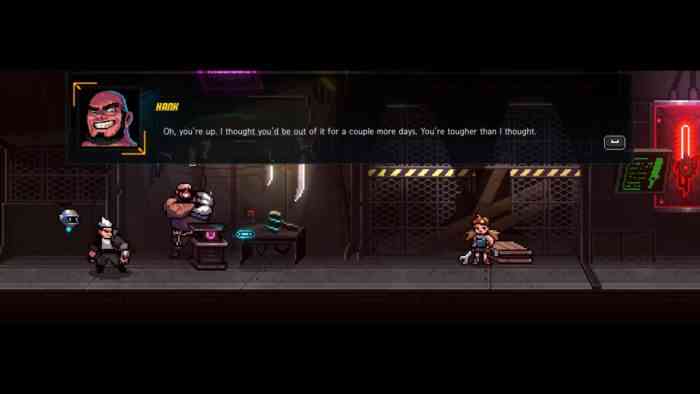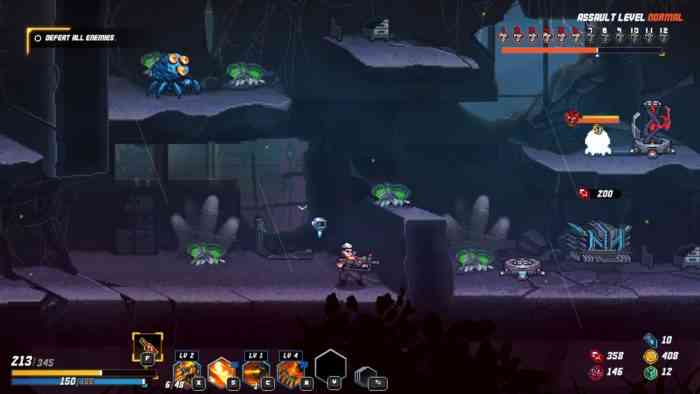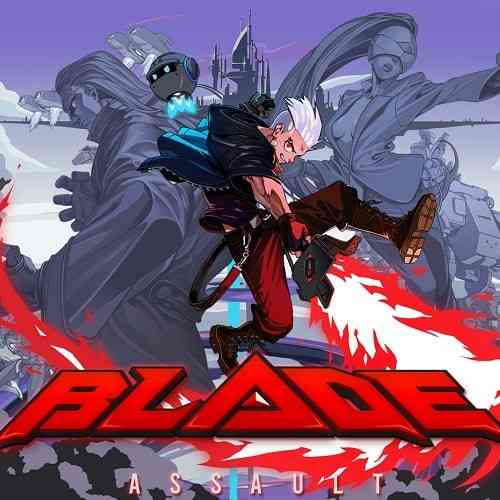Blade Assault Preview
Starting up Blade Assault plunges you right into the middle of a cyberpunk action movie. By which I mean, the story opens with the young cyborg protagonist, Kil, already locked up on the floating city of Esperanza, and you spend the opening level orchestrating his jailbreak while gradually figuring out who he is–and what he was imprisoned for. The game moves at a breakneck pace, throwing hordes of enemies at you before you’re even familiar with the controls, which sounds like a recipe for disaster. However, in practice, it worked extremely well. After a brief period of desperate key smashing, I found myself immersed in Blade Assault’s stylish pixel art world and slick combat.
As it turns out, Kil was formerly an agent of Esperanza’s corrupt regime who turned on his superiors, Electra and Panus, after realizing that Panus was responsible for his parent’s deaths. While Electra wishes to have Kil immediately executed, Panus seems to have some sort of attachment to Kil… or perhaps he simply wants to get more use out of him. Either way, the playable prologue ends with Kil swearing vengeance and Electra throwing him off a floating city. Then Kil wakes up in the aptly named Undercity, the monster-infested slums beneath Esperanza, his robotic arm freshly repaired by the resistance. Though he’s not interested in saving the Undercity, he is very interested in carving his way through Esperanaz’s government, so he joins up. This is where the game truly begins.
A Playable Cyberpunk Action Movie
Blade Assault is very linear, especially for a rogue-lite, but that’s not a knock against it. The narrow focus helps create a constant sense of forwarding momentum, which is very important because the lack of procedural generation in the levels means you spend a lot of time replaying almost exactly the same areas. Between runs, you return to the hub area–a neon-lit jazz bar where the other playable characters and various NPCs hang out. At the bar, you can spend various currencies gathered in each runs to strengthen your bonds with other characters, which improves their services, unlocks their backstories, and helps advance through the narrative. You can also buy permanent upgrades and set the skills for a given run.
The game’s pixel art graphics are stunning. Its beautiful pixel art graphics manage to capture both the gritty neon of top-notch cyberpunk and the shining gold of a corrupt paradise. Each environment has something enjoyable to look at and explore, whether you’re in a town section or actively fighting for your life. Seriously, this game manages to make a sewer level visually interesting—a sewer level. The electronic/jazz soundtrack is also very fitting for a fast-paced cyberpunk game about carving a bloody path through a world that’s failed you. The writing has quite a few typos and tends to feel awkward during the story, but I was able to overlook that.

Combat moves at a breakneck pace. It’s impossible to remain stationary when hordes of enemies flood the screen at once, and some of them move faster than you. I spent much of the tutorial panicking because I couldn’t pause long enough to read the button prompts, but the opening was forgiving enough to let me learn by trial and error. As time passes, the assault level will gradually increase, meaning you’ll be faced with more and more difficult opponents. Defeat enemies for various currencies that can be used to buy randomized power-ups. There’s a wide variety of possible upgrades, all of which will noticeably tweak your move set, so there’s a lot of fun to be had with customization. In general, you should do okay if you keep moving, use special moves often, and try to take out ranged enemies first. Dash attacks are also invaluable, but the base dash doesn’t do any damage, which brings us to upgrade and customization options.
Incredibly Slick Controls
As of writing, Kil is the only playable character, and there are three available weapons for him: a slow but powerful axe, a long-ranged gun that demands periodic breaks for reloading, and a fast sword that’s good for combos. Each weapon has its own passive abilities that can be applied and upgraded. Three different elements can be applied to each weapon, but while you can choose your passive skill in the hub, the elements are encountered randomly during a run. Your first upgrade point will be selected at random. After that, you’ll have the option of picking between 1 and 2 doors marked with the icons of various elements. Different elements can bestow different abilities that will interact differently with specific weapons. If you have the gun, stock up on abilities that boost damage from range, for example, but it would be a bad idea to take those upgrades if you’re using the axe. I got the best results with the gun, but generally, I let the random number god select elemental specialties for me.

There’s also a fourth option for support upgrades marked by a heart. Damage, shields, skills, and dash upgrades are important, so I don’t recommend focusing on support upgrades, but I also don’t recommend neglecting them completely. This isn’t a game where taking one hit will kill you instantly. You’ll be in trouble during boss fights if you can’t absorb some hits. Of course, you’ll be in trouble anyway because the boss fights are brutal.
While the combat may move a bit too quickly for some players’ liking, the linearity may eventually feel repetitive, and the writing is a bit lackluster; I had a lot of fun with Blade Assault. The lack of options available in the current Early Access build leaves me looking forward to the finished product.
***PC code provided by the publisher***

